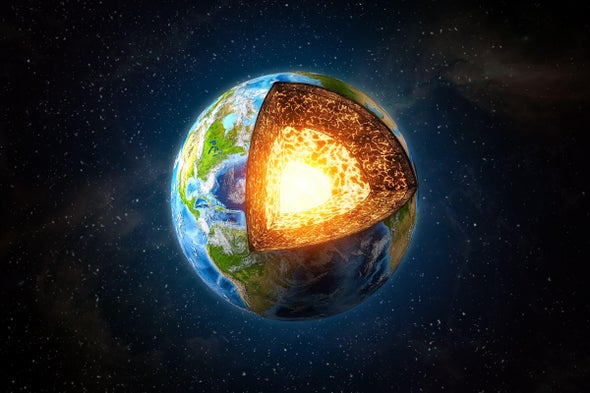
Gear-obsessed editors choose every product we review. We may earn commission if you buy from a link. Why Trust Us?
- Every 8.5 years or so, the Earth emits a signal—the result of a “wobble” occurring in the inner core.
- To explain this phenomenon, scientists from Wuhan University analyzed polar movement and length-of-day changes, and concluded that the inner core is 0.17 degrees off of the rotational axis of the mantle.
- Although this idea goes against the conventional theory of the core-mantle relationship, it could help explain other geomagnetic phenomena.
Few things are more vital to our existence—yet less understood—than the Earth’s inner core. Surrounded by a cocoon of liquid metal (aka the outer core), this solid mass of nickel and iron at the planet’s heart is what creates the Earth’s magnetic field, which protects all life from harmful solar radiation. Despite this essential, life-sustaining function, the inner core remains a huge mystery for geologists eager to understand the deep workings of the world.
For example, scientists had noticed that the inner core tends to wobble, but had no clue why. Now, scientists at Wuhan University hope to at least check this one seismic oddity off the mystery list. Their study, published this month in the journal Nature Communications, argues that this “Inner Core Wobble” (ICW) occurs every 8.5 years and implies that the static tilt of the core is 0.17 degrees different from the rotation axis of the mantle. The team came to this conclusion by studying polar motion (PM) and length-of-day changes (ΔLOD).
“This implies a potential eastward differential rotation angle of the inner core of less than 1 degree and misalignment in the symmetry axes of the lower mantle/core-mantle boundary layer with the upper mantle,” Wuhan University research and study co-author Hao Ding said in an interview with Phys.org. “These deviations offer valuable constraints for the 3D density model of the mantle and question assumptions in the liquidity-core oblate, highlighting potential deviations from a perfectly spherical form calculated using traditional theories.”
In another study from 2018, Ding first discovered evidence of the 8.5-year harmonious signal while studying the subtle movement of Earth’s poles over time. The core’s tilt, as compared to the mantle, goes against the typical hypothesis that the tilt of those two layers are in sync. Ding also thinks that the origin of this “signal” could explain why the Earth’s magnetic field changes over time.
“The static tilt may also lead to a certain change in the shape of the liquid core, resulting in a change in the fluid motion and a corresponding change in the geomagnetic field,” Ding said in the interview.
While this theory explains some of the mysterious oddities surrounding the Earth’s inner core, it’s only one theory among several. As Vice notes, one idea points the finger instead at the push-and-pull forces between the Earth’s magnetic field and its gravitational field. Another focuses on the irregular shape of the core itself.
And while humans can’t simply travel to the center of the Earth (despite what sci-fi may tell you) geologists will continue analyzing the subtle hints—whether earthquake rumbles or harmonic wobbles—to figure out the amazing, life-sustaining machinations at the heart of the planet we call home.


